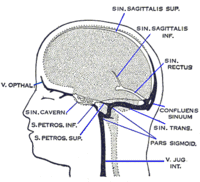
Photo from wikipedia
OBJECTIVE The posterior petrosal approach is an established surgical method offering wide access to skull base lesions through mastoid air cells. The authors describe their experience with the endoscopic transmastoid… Click to show full abstract
OBJECTIVE The posterior petrosal approach is an established surgical method offering wide access to skull base lesions through mastoid air cells. The authors describe their experience with the endoscopic transmastoid "posterior petrosal" approach (EPPAP) for skull base tumors involving the internal auditory canal (IAC), jugular foramen, and hypoglossal canal. METHODS The EPPAP was performed for 7 tumors (3 chordomas, 2 chondrosarcomas, 1 schwannoma, and 1 solitary fibrous tumor). All surgical procedures were performed under endoscopic visualization with mastoidectomy. The compact bone of the mastoid air cells and posterior surface of the petrous bone are carefully removed behind the semicircular canals. When removal of cancellous bone is extended superomedially through the infralabyrinthine space, the surgeon can expose the IAC and petrous portion of the internal carotid artery to reach the petrous apex (infralabyrinthine route). When removal of cancellous bone is extended inferomedially along the sigmoid sinus, the surgeon can safely reach the jugular foramen (transjugular route). Drilling of the inferior surface of petrous bone is extended further inferoposteriorly behind the jugular bulb to approach the hypoglossal canal and parapharyngeal space through the lateral aspect of the occipital condyle (infrajugular route). RESULTS Of the 7 tumors, gross-total resection was achieved in 4 (57.1%), subtotal resection (> 95% removal) in 2 (28.6%), and partial resection (90% removal) in 1 (14.2%). Postoperatively, 2 of 3 patients with exudative otitis media showed improvement of hearing deterioration, as did 2 patients with tinnitus. Hypoglossal nerve palsy and swallowing difficulty were improved after surgery in 2 patients and 1 patient, respectively. In 1 patient with severe cranial nerve deficits before surgery, symptoms did not show any improvement. CONCLUSIONS The authors present their preliminary experience with EPPAP for skull base tumors in the petrous part of the temporal bone and the lateral part of the occipital condyle involving the cranial nerves and internal carotid arteries. The microscope showed a higher-quality image and illumination in the low-power field. However, the endoscope could offer wider visualization of the surgical field and contribute to minimizing the size of the surgical pathways, necessity of brain retraction, and eventually the invasiveness of surgery. Thus, the EPPAP may be safe and effective for skull base tumors in the petrous region, achieving balance between the radicality and invasiveness of the skull base surgery.
Journal Title: Journal of neurosurgery
Year Published: 2019
Link to full text (if available)
Share on Social Media: Sign Up to like & get
recommendations!